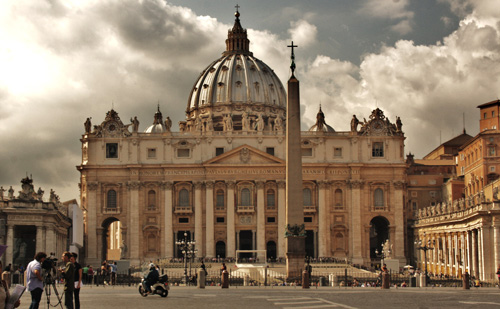FEAST OF SAINTS PETER AND PAUL
HOLY MASS FOR THE IMPOSITION OF THE SACRED PALLIUM
ON METROPOLITAN ARCHBISHOPS
HOMILY OF HIS HOLINESS BENEDICT XVI
Vatican Basilica
Friday, 29 June 2012
Your Eminences,
Brother Bishops and Priests,
Dear Brothers and Sisters,
We are gathered around the altar for our solemn celebration of Saints Peter and Paul, the principal Patrons of the Church of Rome. Present with us today are the Metropolitan Archbishops appointed during the past year, who have just received the Pallium, and to them I extend a particular and affectionate greeting. Also present is an eminent Delegation from the Ecumenical Patriarchate of Constantinople, sent by His Holiness Bartholomaios I, and I welcome them with fraternal and heartfelt gratitude. In an ecumenical spirit, I am also pleased to greet and to thank the Choir of Westminster Abbey, who are providing the music for this liturgy alongside the Cappella Sistina. I also greet the Ambassadors and civil Authorities present. I am grateful to all of you for your presence and your prayers.
In front of Saint Peter’s Basilica, as is well known, there are two imposing statues of Saint Peter and Saint Paul, easily recognizable by their respective attributes: the keys in the hand of Peter and the sword held by Paul. Likewise, at the main entrance to the Basilica of Saint Paul Outside the Walls, there are depictions of scenes from the life and the martyrdom of these two pillars of the Church. Christian tradition has always considered Saint Peter and Saint Paul to be inseparable: indeed, together, they represent the whole Gospel of Christ. In Rome, their bond as brothers in the faith came to acquire a particular significance. Indeed, the Christian community of this City considered them a kind of counterbalance to the mythical Romulus and Remus, the two brothers held to be the founders of Rome. A further parallel comes to mind, still on the theme of brothers: whereas the first biblical pair of brothers demonstrate the effects of sin, as Cain kills Abel, yet Peter and Paul, much as they differ from one another in human terms and notwithstanding the conflicts that arose in their relationship, illustrate a new way of being brothers, lived according to the Gospel, an authentic way made possible by the grace of Christ’s Gospel working within them. Only by following Jesus does one arrive at this new brotherhood: this is the first and fundamental message that today’s solemnity presents to each one of us, the importance of which is mirrored in the pursuit of full communion, so earnestly desired by the ecumenical Patriarch and the Bishop of Rome, as indeed by all Christians.
In the passage from Saint Matthew’s Gospel that we have just heard, Peter makes his own confession of faith in Jesus, acknowledging him as Messiah and Son of God. He does so in the name of the other Apostles too. In reply, the Lord reveals to him the mission that he intends to assign to him, that of being the “rock”, the visible foundation on which the entire spiritual edifice of the Church is built (cf. Mt16:16-19). But in what sense is Peter the rock? How is he to exercise this prerogative, which naturally he did not receive for his own sake? The account given by the evangelist Matthew tells us first of all that the acknowledgment of Jesus’ identity made by Simon in the name of the Twelve did not come “through flesh and blood”, that is, through his human capacities, but through a particular revelation from God the Father. By contrast, immediately afterwards, as Jesus foretells his passion, death and resurrection, Simon Peter reacts on the basis of “flesh and blood”: he “began to rebuke him, saying, this shall never happen to you” (16:22). And Jesus in turn replied: “Get behind me, Satan! You are a hindrance to me …” (16:23). The disciple who, through God’s gift, was able to become a solid rock, here shows himself for what he is in his human weakness: a stone along the path, a stone on which men can stumble – in Greek, skandalon. Here we see the tension that exists between the gift that comes from the Lord and human capacities; and in this scene between Jesus and Simon Peter we see anticipated in some sense the drama of the history of the papacy itself, characterized by the joint presence of these two elements: on the one hand, because of the light and the strength that come from on high, the papacy constitutes the foundation of the Church during its pilgrimage through history; on the other hand, across the centuries, human weakness is also evident, which can only be transformed through openness to God’s action.
(To continue reading, please see here).

